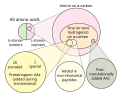Proteinogenic amino acid
(Redirected from Proteinogenic amino acids)
Proteinogenic Amino Acid
A proteinogenic amino acid is an organic compound that serves as a building block for proteins. These amino acids are essential for the synthesis of proteins in living organisms. They are characterized by the presence of an amino group (-NH2) and a carboxyl group (-COOH) attached to a central carbon atom, known as the alpha carbon. Additionally, they have a side chain, also known as an R-group, which varies among different amino acids.
Classification
Proteinogenic amino acids can be classified into several categories based on their properties and functions. One common classification is based on the polarity of the side chain:
1. Nonpolar Amino Acids: These amino acids have hydrophobic side chains that do not interact with water molecules. Examples include glycine, alanine, valine, leucine, isoleucine, proline, methionine, and phenylalanine.
2. Polar Amino Acids: These amino acids have hydrophilic side chains that can form hydrogen bonds with water molecules. Examples include serine, threonine, cysteine, tyrosine, asparagine, and glutamine.
3. Positively Charged (Basic) Amino Acids: These amino acids have positively charged side chains at physiological pH. Examples include lysine, arginine, and histidine.
4. Negatively Charged (Acidic) Amino Acids: These amino acids have negatively charged side chains at physiological pH. Examples include aspartic acid and glutamic acid.
Functions
Proteinogenic amino acids play crucial roles in various biological processes:
1. Protein Synthesis: Amino acids are the building blocks of proteins. During protein synthesis, amino acids are linked together through peptide bonds to form polypeptide chains. The sequence of amino acids determines the structure and function of the protein.
2. Enzyme Catalysis: Some amino acids, such as histidine and serine, act as catalytic residues in enzymes. They participate in chemical reactions by donating or accepting protons or electrons.
3. Cell Signaling: Amino acids, such as glutamate and glycine, serve as neurotransmitters in the nervous system. They transmit signals between nerve cells, allowing for proper communication and coordination.
4. Metabolism: Amino acids are involved in various metabolic pathways. For example, phenylalanine is converted into tyrosine, which is further metabolized to produce important molecules such as dopamine, adrenaline, and thyroid hormones.
Importance in Nutrition
Proteinogenic amino acids are essential nutrients for humans and other animals. They cannot be synthesized by the body and must be obtained through dietary sources. A balanced diet should include all essential amino acids to support proper growth, development, and maintenance of bodily functions.
References
See Also
Transform your life with W8MD's budget GLP-1 injections from $125.
W8MD offers a medical weight loss program to lose weight in Philadelphia. Our physician-supervised medical weight loss provides:
- Most insurances accepted or discounted self-pay rates. We will obtain insurance prior authorizations if needed.
- Generic GLP1 weight loss injections from $125 for the starting dose.
- Also offer prescription weight loss medications including Phentermine, Qsymia, Diethylpropion, Contrave etc.
NYC weight loss doctor appointments
Start your NYC weight loss journey today at our NYC medical weight loss and Philadelphia medical weight loss clinics.
- Call 718-946-5500 to lose weight in NYC or for medical weight loss in Philadelphia 215-676-2334.
- Tags:NYC medical weight loss, Philadelphia lose weight Zepbound NYC, Budget GLP1 weight loss injections, Wegovy Philadelphia, Wegovy NYC, Philadelphia medical weight loss, Brookly weight loss and Wegovy NYC
|
WikiMD's Wellness Encyclopedia |
| Let Food Be Thy Medicine Medicine Thy Food - Hippocrates |
Medical Disclaimer: WikiMD is not a substitute for professional medical advice. The information on WikiMD is provided as an information resource only, may be incorrect, outdated or misleading, and is not to be used or relied on for any diagnostic or treatment purposes. Please consult your health care provider before making any healthcare decisions or for guidance about a specific medical condition. WikiMD expressly disclaims responsibility, and shall have no liability, for any damages, loss, injury, or liability whatsoever suffered as a result of your reliance on the information contained in this site. By visiting this site you agree to the foregoing terms and conditions, which may from time to time be changed or supplemented by WikiMD. If you do not agree to the foregoing terms and conditions, you should not enter or use this site. See full disclaimer.
Credits:Most images are courtesy of Wikimedia commons, and templates, categories Wikipedia, licensed under CC BY SA or similar.
Translate this page: - East Asian
中文,
日本,
한국어,
South Asian
हिन्दी,
தமிழ்,
తెలుగు,
Urdu,
ಕನ್ನಡ,
Southeast Asian
Indonesian,
Vietnamese,
Thai,
မြန်မာဘာသာ,
বাংলা
European
español,
Deutsch,
français,
Greek,
português do Brasil,
polski,
română,
русский,
Nederlands,
norsk,
svenska,
suomi,
Italian
Middle Eastern & African
عربى,
Turkish,
Persian,
Hebrew,
Afrikaans,
isiZulu,
Kiswahili,
Other
Bulgarian,
Hungarian,
Czech,
Swedish,
മലയാളം,
मराठी,
ਪੰਜਾਬੀ,
ગુજરાતી,
Portuguese,
Ukrainian
Contributors: Prab R. Tumpati, MD



